When it comes to cat behavior problems, aggression runs rampant in many households. In the wild, cats exhibit hostility to dominate another individual. The main goal is to defend himself against a real or perceived threat. However, in domestic cats, there are also other origins of this dangerous behavior.
The causes for which cats become aggressive are as follows: pain-induced aggression, fear aggression, redirected aggression, play aggression, petting-induced aggression, predatory aggression, state-related aggression, maternal aggression, territorial aggression, non-recognition aggression, and idiopathic aggression.
Did you know that aggressive behavior is the reason why 27% of cats are returned to shelters?
Aggression poses a real problem for cat owners.
In fact, even though aggressive behavior is normal for wild cats, it is not for domestic ones.
So if you are currently living with an aggressive cat, chances are your feline friend is suffering to some degree. And he or she needs your help.
In this article, you will learn what triggers aggression in cats, why they behave that way, and how to deal with it. As a result, you’ll put a stop to your cat’s suffering, avoid dangerous episodes, and live a happier life at home.
Let’s get started.
What Is Cat Aggression?
Aggression is defined as hostile behavior whose purpose is to dominate another individual. (person or animal). Tough, aggression is a term that covers a wide range of behaviors.
It is a fairly common behavior problem in cats forced to share the same resources or that have experienced situations of abuse.
All wild animals, to varying degrees, are aggressive. The main goal is to protect the individual from a real or perceived threat.
This is how animals defend their territories, their offspring, and themselves in case of an attack.
Many triggers make cats aggressive. That’s why coming up with strategies to stop aggressive feline behavior is difficult (but doable).
As you keep reading through this article, you’ll discover all the potential triggers that lead to aggression. Also, you’ll learn how to address and solve them in case your cat shows this behavior.
Why Do Cats Become Aggressive?

Cats become aggressive because they are suffering emotionally or physically. The main causes of aggression are usually related to:
- Fear, anxiety, or stress.
- Social pressure.
- Sexual impulse.
- Rough playing.
- Illness or pain.
- Frustration.
Cats will become more aggressive if they are:
- Not castrated,
- Unable to hunt,
- Misunderstood by their owner,
- Deprived of essential resources,
- Kept indoors without any sort of stimulation.
Before getting into the details of what causes the aggression, let’s look at the physical signs that cats exhibit. The first step is to recognize them based on your cat’s body language.
What Are the Signs of an Aggressive Cat?
Cats communicate their feelings and emotions through body language. It is, in fact, one of the four types of feline communication.
Learning to “read aggressive body language behavior” will allow you to:
- Prevent injuries to pets and other people
- Understand your cat’s motivations and feelings and…
- Deal more effectively with this problem.
Body language in cats is very subtle, making it more difficult to decipher for the untrained eye. The position of certain body parts, such as the ears, tail, and whiskers, as well as facial expressions and body postures, make this up.
Cats can display aggressive behavior in both offensive and defensive contexts.
Offensive Body Posture:
An offensive cat will try to intimidate their target and choose a posture that makes it appear larger.
The goal is to keep others from coming closer. Cats adopt a threat posture, warning others away by appearing as formidable as possible.
They do this by arching their backs, swishing their tails, and standing sideways as tall as they can. Their fur stands on end (piloerection) and their pupils dilate.
Offensive posture includes:
- Arched back.
- Pilo-erect fur.
- Ears held flat.
- Dilated pupils.
- Paw ready to swat.
- Curved and swishing tail.
- Pulled back whiskers.
- Directly facing the opponent.
- The tail is stiff and lowered.
- Growling, howling, or yowling.
- Erect posture with straight legs.
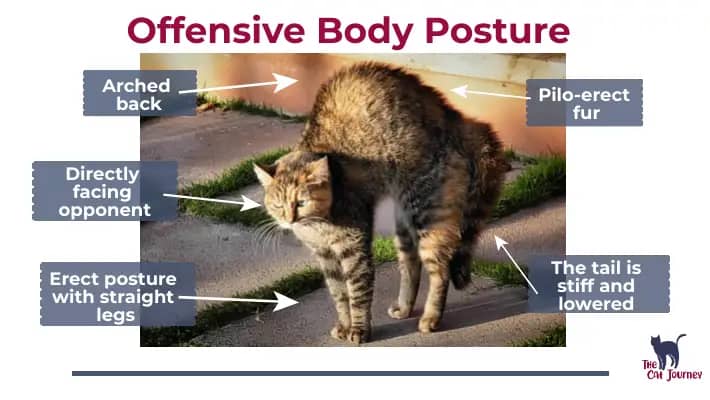
Defensive Body Posture:
A defensive cat will avoid confrontation at all costs and adopt a self-protective posture to appear smaller.
The goal is to warn you to stay away. When a cat feels unable to avoid an interaction with a more dominant animal, he prepares to defend himself.
The head and neck are pressed against the body for protection. The ears are pushed back and almost flat against the head.
The face muscles tense up, revealing one of his weapons: his teeth. The cat slowly rolls to the side, revealing his claws, his second weapon. He’s now ready to defend himself.
Defensive posture includes:
- Crouching.
- Head tucked in.
- Tail curved around the body.
- Open-mouthed hissing or spitting.
- Eyes wide open and pupils dilated.
- Paw ready to swat with claw exposed.
- Facial muscles tensed. displaying teeth.
- Ears pulled flat and back against the head.
- Rolling over on one side to better show claws.
- Whiskers pulled front to assess the distance of the danger.
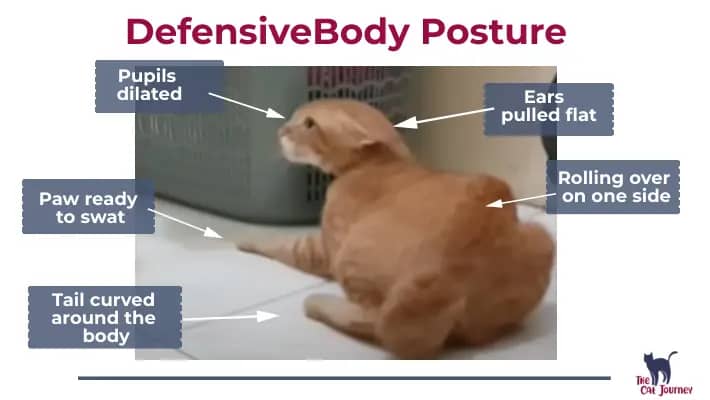
Aggression, Whether Defensive or Offensive
Includes the following behaviors:
- Biting;
- Fighting;
- Swatting;
- Scratching;
- Growling, yowling, and hissing.
Remember to keep a safe distance because if the cat perceives us as a danger, he will attack.
What Causes a Cat to Become Aggressive
The 11 Types of Aggressions in Cats
Recent studies have shown that aggressive behavior accounts for 27% of cats abandoned in shelters.
However, with the right knowledge, this sad percentage can be changed. Caregivers must learn to see the world through their cat’s eyes to understand their feelings.
Let’s look at what causes cats to become aggressive in the first place:
- Pain-induced aggression.
- Fear aggression.
- Redirected aggression.
- Play aggression.
- Petting-induced aggression.
- Predatory aggression.
- Status-related aggression.
- Maternal aggression.
- Territorial Agression.
- Non-recognition aggression.
- Idiopathic aggression.
Fortunately, once you understand the trigger(s) that drive your cat’s behavior, you can stop most aggressions.
While some are obvious, others are more subtle. Spotting them will require patience and careful observation on your part. Now let’s take a closer look at each one:
# 1 Pain-Induced Aggression
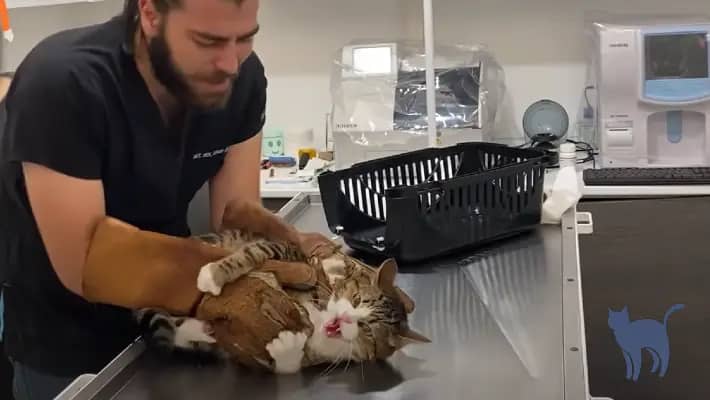
The first step in managing an aggressive cat is to rule out any health conditions that may be causing this behavior.
Cats act aggressively when they are in pain. They do it to avoid contact that can make the suffering worse.
The same goes for cats suffering from mental diseases. In this case, the cats’ suffering is caused by a chemical reaction in their brains that gives them information that is not real.
Hyperthyroidism, osteoarthritis, dental disease, and neurological issues can all be painful for your pet. Keep in mind that cats are masters at hiding pain. It helps them stay alive in the wild. But just because they don’t express it doesn’t mean they aren’t in pain.
Cats with osteoarthritis, for example, may react by hissing, biting, or scratching when their joints are touched. When a cat is injured, even the most well-socialized and docile one attacks.
Once the pain is gone, normally, the aggressive behavior goes away. However, on rare occasions, some cats may continue to act aggressively. Presumably, to prevent feeling the same pain they felt in the past.
A simple way to avoid pain-induced aggression is to avoid touching painful areas of your cat’s body.
And before trying any of the behavioral or environmental solutions (covered later on), make sure you visit the vet to check for underlying medical issues.
# 2 Fear Aggression

Fear aggression occurs when a cat is faced with a threat, real or perceived, and has no way out.
This type of aggression appears when a cat encounters unfamiliar stimuli, such as a new person, a new animal, or loud noises.
It can also be the result of learned behavior based on unpleasant experiences in the past. For instance a visit to the vet. The more threatening the stimulus appears to him, the more intense his fear reaction will be.
Identifying and avoiding situations that trigger a fear response is the best option for dealing with it. For example, providing hiding places will calm your cat down.
# 3 Redirect Aggression

Redirected aggression occurs when a cat becomes frustrated or agitated by a stimulus that it cannot reach.
Unable to access the source of his agitation, he turns and lunges at someone in the vicinity—a person, a dog, or a cat.
Below are the common triggers for redirected aggression:
- Sniffing an unknown cat’s scent on a family member, or a visitor.
- Seeing another cat through a door or window.
- Seeing birds, squirrels, or other prey animals.
- Fighting with another cat in the house.
- Getting scared or harassed by a dog.
- Frightening noises or smells.
Redirected aggression is very dangerous as the attacks are uninhibited. They are in a state of mind known as “fight or flight.” For them, it’s all about survival. That may sound strange, but unfortunately, it is very common.
Oddly enough, redirected aggression can happen with a significant delay. The time between initial excitement and aggression can last several hours. Many cat owners experienced “unexpected” aggression since they were unaware of the initial trigger.
Keep in mind that the cat will not go looking for someone to attack! It is not a malicious or deliberate form of aggression. It’s like a reaction that happens automatically and without thought.
If this type of aggression is common in your house, you have two solutions at hand.
- The first one is to remove the stimuli from their daily routine. For example, if a stray cat is the “trigger”, lower a window shade, hang a curtain, or stop feeding stray cats in your backyard.
- The second solution is to give your cat enough exercise to tire her and spend that extra energy that leads to these random attacks.
Last but not least, you should allow her to enjoy some time outside. Naturally, only do it if you are sure your cat won’t get hurt or lost.
# 4 Play Aggression
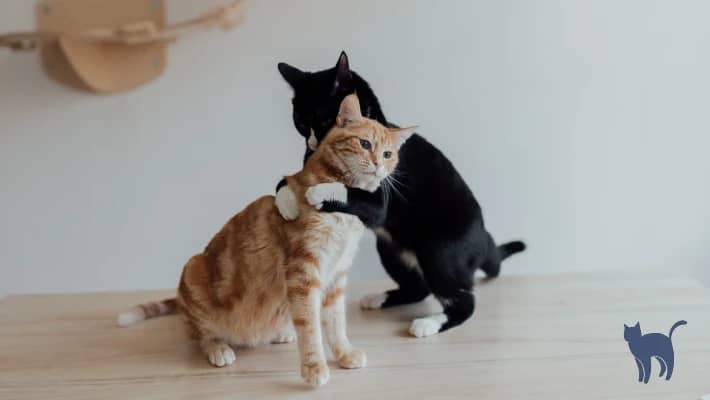
Kittens and cats under the age of two are prone to rough play. The idea of attacking is ingrained in their minds, and they learn their first hunting lessons through play.
For cats, playing with a toy is like hunting for prey.
Predatory behaviors such as stalking, chasing, attacking, running, grabbing, fighting, and biting are examples of play aggression.
Young cats learn to limit their bites and sheathe their claws when they strike hard by playing with one another.
They realize they are biting or scratching too hard when their brothers and sisters stop playing with them.
Learning how to play properly is an important part of a cat’s socialization. Orphaned or weaned cats may never have learned to moderate their play behavior.
Other factors that may contribute to play aggression include:
- Spending long periods alone with no opportunities to play,
- Owners who encourage their cats to chase and attack their hands and feet during play.
Cats who are about to engage in play aggression frequently have:
- Their tails wagging from side to side,
- Their ears flat against the tops of their heads, and
- Their pupils dilated.
They can stalk their “prey”, whether animal or human and often leap out of cover when the prey passes by.
To intervene in play aggression, first determine if there is a pattern of when and where aggressive behavior occurs. If so, distract the cat with games or deny access to places that encourage the behavior. For instance, under the bed, if the cat hides there before jumping.
Walking away and ignoring the cat is an effective method. This way you are teaching them that inappropriate play results in no play at all. Indeed, this is how the mother teaches her kittens how to socialize well.
The goal is not to scare the cat, but to divert its attention to the toy.
Any object used to distract a cat from play aggression should be kept away from your hands. So the cat does not bite or scratch you, instead, he’ll vent his anger on the toy.
Give them an appropriate “victim,” such as the wanded toy shown in the photo below.
During these playtimes, never physically punish or even touch a cat. This can make the cat fearful of people or be misinterpreted as play, which can inadvertently reward aggressive behavior.
# 5 Petting-Induced Aggression
Petting-induced aggression occurs when a cat who enjoys being petted, abruptly changes his mind. He becomes tired, attacks you, and flees.
This happens because either the cat feels overstimulated or just wants to stop the petting session.
Overstimulation is a physiological phenomenon involving hair follicle receptors.
After a certain amount of petting, which varies from cat to cat, their nerve endings just start to register pain rather than pleasure.
After a certain amount of petting, which varies from cat to cat, their nerve endings just start to register pain rather than pleasure.
It’s like when someone hugs you for too long and you start to feel uneasy.
Bathing, grooming, and nail clipping can also result in this type of aggression.
Petting-induced aggression is very common in households for a simple reason: cats prefer brief and frequent interactions with humans. Pet owners, instead, prefer having less frequent but more intense interactions.
This means that if you want to avoid this kind of behavior, you should try to interact with your cat in a way he or she is more comfortable with. Especially with males, who are more likely to snap.
When your cat shows that it had enough, the best response is to stop.
This behavior can appear misleading to a loving pet owner. It’s even more annoying when your cat asks for attention, and then, a few minutes later, bites or claws you, even if you didn’t do anything.
You can address petting-induced aggression by following these five tips:
- Look out for the cat’s subtle warning signs (mentioned above)
- Avoid touching or caressing without invitation,
- Avoid petting vulnerable parts of their body (belly, chest, or back).
- Do not try to pick up or interact with the cat while he is eating.
- Reward your cat with a treat when she allows you to pet her.
Over time, owners can gradually increase the duration of petting. But at any signs of aggression, the owner should stop petting and begin a cool-down period without physical contact.
In case you have children at home, stop them from having physical contact with the cat if he or she has a history of petting-induced aggression. Children usually can’t recognize visual cues that tell whether a cat wants to be petted or not.
# 6 Status-Related Aggression
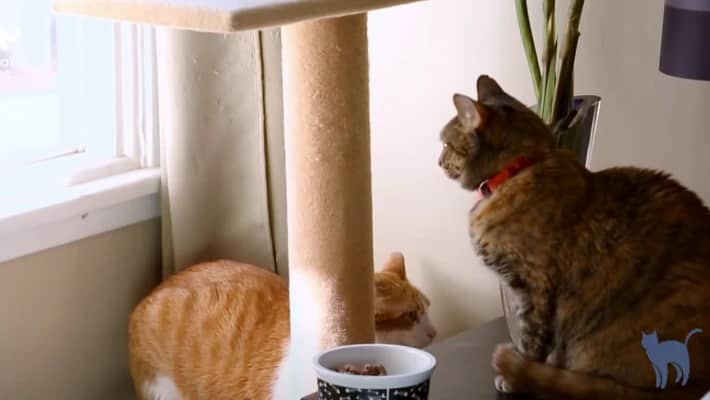
Status-related aggression happens when a cat wants to establish its social dominance. These cats may show signs of aggression towards people or other pets. Here are some examples:
- Cats who use their body to block doors,
- Cats who hit other cats as they pass,
- Cats who growl when you try to move them,
- Cats who bite when their owners pay attention to other pets.
From a psychological standpoint, the cat feels that nothing belongs to him and attempts to take possession of everything by force.
You can address status-induced aggression by following these three tips:
- Ignore the offending cat completely. Give attention only when the cat is calm. A relaxed cat will not hiss or swat and will have normal-sized pupils, upright ears, and a normal tail posture. The tail stands upright without twitching or standing on end.
- Place your scent where the cat usually sits. Cats like to mix their scents with your scents. In this way, they feel secure and safe. You can make another area for him to play or rest and place your scent there. For example, rub an old shirt of yours on the fabric.
- Adding more vertical spaces. Make sure your cat feels there are enough resources for everyone. As a result, he will not feel compelled to protect specific areas. The more beds, trees, and supplies you have spread out around the house, the better. There is no way he’ll defend all those little points at the same time.
# 7 Predatory Aggression

Predatory aggression is not considered aggression by many experts.
Why?
Because a cat’s only goal is to get food. Unlike the other types of aggression, which rise as a response to conflict.
Cats’ predatory behavior is both instinctive and learned. Kittens practice hunting skills by playing with their littermates. They also learn from their mother’s example. They hone their skills through trial and error over time.
Hunting is so ingrained in them that even well-fed domestic cats react innately and hunt down prey that crosses their path.
Insects, reptiles, rodents, baby rabbits, and birds are all prey for cats. Most specialize in rodents like mice and voles, but some become skilled at killing birds as well.
When it comes to predatory aggression, cat owners are most concerned about two contexts.
The first is related to bird hunting. Many bird species have suffered extreme population declines in the wild. Researchers believe this is happening because of the high number of domestic and feral cats roaming outside.
The second is related to the prey’s presentation to the owners. This behavior horrifies many people, especially if the prey is half-eaten or injured as they see it as unnecessary behavior. Besides, these cats are well-fed and are not killing because they are hungry.
However, from the feline’s perspective, it is a redirected maternal behavior that induces cats to carry the prey to their “den” to feed their offspring.
It is difficult to eradicate the cat’s predatory aggressiveness because it is a natural part of feline behavior. The only way to address this undesirable behavior is to prevent it from occurring in the first place.
How?
The most obvious thing to do is to not let your cat go outside. However, if you are the type of owner who thinks that your cat’s freedom comes first, you have these other less effective but practical options.
Diverting and redirecting the predatory trend toward more acceptable “victims” like toys. Interactive toys are the best because they encourage predatory play.
Another important tip is to rotate the toys regularly because cats get tired of playing the same game over and over.
# 8 Non-Recognition Aggression
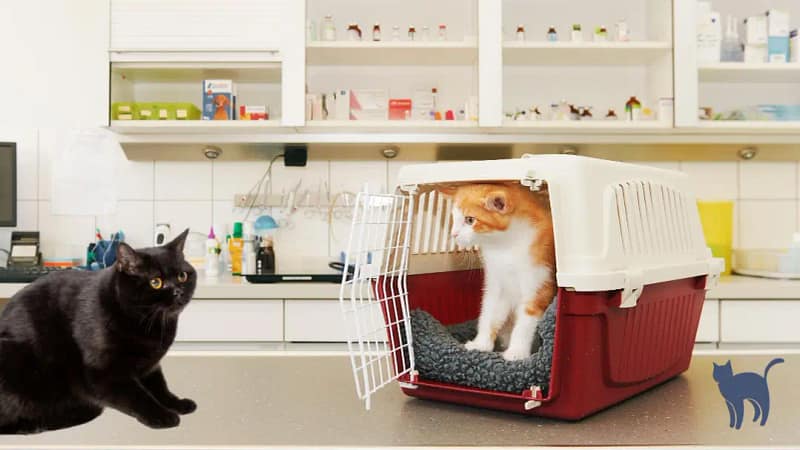
Non-recognition aggression occurs when a cat behaves aggressively toward another cat in the family after a period of separation.
A typical example is when a cat returns home from the vet. The cat comes back home with a different smell the others do not recognize.
And when they do, like the smell of alcohol or disinfectant, it reminds them of a past bad experience at the vet’s office.
If you are living this issue at home, don’t worry, there is a solution. The key is reintroducing your cats in a very logical, step-by-step, non-threatening way.
Take the following 4 steps before introducing him to the other cats:
- Make sure your cat is recovered from sedation,
- Clean your cat to get rid of veterinary smells
- Rub your scent into the cat using a worn shirt,
- Keep your returning cat apart while they remember each other’s sounds and smells.
These simple guidelines will ensure the other cats won’t attack the returning cat. There will be no aggression at all.
# 9 Maternal aggression

Maternal aggression occurs when a cat (“the queen”) becomes especially aggressive after giving birth.
Humans, other cats, and other pets can all become targets of aggression. Her ultimate goal is to protect her kittens from any potential danger.
The aggression, particularly toward male cats, is justified since male cats are known to cannibalize kittens.
Hormones present in her body after giving birth, particularly in the first few days, are also a trigger for her aggression. These can have an impact on her normal behavior and how she reacts.
To prevent the cat from becoming stressed, avoid touching the newborn kittens. Keep onlookers away and provide a quiet spot. It is also important not to change the odor of the nest.
This behavior typically lasts three to four weeks after the kittens are born. The period when kittens are most vulnerable also coincides with the peak of their hormones.
As the kittens grow older, their aggression lessens until it disappears entirely.
# 10 Territorial Aggression

Territorial aggression occurs when a cat perceives that an intruder has invaded its territory.
Cats are extremely territorial animals. It is part of their evolutionary process as a species. They fight to protect the area in which they can hunt, feed, and reproduce.
The “invader” is usually another cat, but aggression can also be directed at dogs and humans.
Depending on where your cat spends his or her time, the perceived territory may be all or part of the house, the yard, the block, or even the neighborhood.
Male and female cats are both territorial, but males’ territories are often larger.
Oddly enough, a cat may display territorial aggression toward some family members but not others, as well as toward some cats but not others.
Are you wondering how a cat tells which territory belongs to him to his rivals?
They do it by acting in these three ways:
- Rubbing their chin against objects,
- Scratching the scratching posts and, if they are outside, trees, and
- Spraying the area’s perimeter with urine.
All to leave his scent impregnated, informing the other cats of his possession, and persuading them to stay out of it.
If the intruder ignores all the warning signs, the cat may stalk, chase, and ambush the newcomer. He will also engage in offensive behavior such as hissing, slapping, and growling.
Every time a cat feels a stranger in his territory, he will feel that the stranger will take it from him.
Here’re some possible triggers:
- The family adopted a new cat.
- A kitten in the house matures sexually.
- Environmental changes (moving or changing furniture).
- Significant changes in the family (new baby or new partner).
- Stray or roaming cats in the neighborhood enter a cat’s territory.
The most common type of territorial aggression cat owners face is when the family decides to adopt a new cat. So it’s key to introduce cats the right way.
Do it carefully because what you’re trying to impart to your resident cat is that there is no danger. Positive association is a key to achieving this.
Make sure that every time your resident cat sees or smells the other cat, good things will happen.
# 11 Idiopathic Aggression

Idiopathic aggression occurs when the triggers for aggression are unknown. Meaning that there’s no way to predict the aggression.
The term “idiopathic” refers to “any disease or condition for which the cause is unknown and which arises spontaneously.”
This type of aggression can be very dangerous because it includes sudden and severe outbursts with little or no warning. It may have a neurological origin, according to experts.
If none of the above situations have occurred:
- Your cat doesn’t live in a small apartment,
- There are no cats outside,
- No prey in the yard, and
- Nothing has happened.
But your cat gets aggressive, it is most likely idiopathic aggression.
Remember that cats, like humans, can suffer from mental illnesses. So there’s a chance that your cat’s brain provides him or her with information that is not real, which leads to the attack.
If your cat suffers from it, you can treat him with psychiatric medications and even apply more holistic approaches. But in those cases, you should schedule an appointment with your veterinarian.
Conclusions
It is not easy to deal with an aggressive cat. Having a pet comes with some risks. However, with the proper knowledge, you can change your cat’s behavior and restore peace in your home.
I hope you enjoyed this thorough overview of the multiple types of aggression displayed by cats.
Now I’d like to hear from you:
- Does your cat exhibit aggressive behavior?
- After reading the post, have you identified what causes your cat’s aggression?
- To whom does he direct his frustration?
Please let me know right now by leaving a quick comment below.
The Cat Journey uses only trusted sources, including peer-reviewed studies. This is how we support the tips and information shared in our articles.
- Feline Behavior Problems: Aggression – Cornell University _ College of Veterinary Medicine.
- Conflict and affiliative behavior frequency between cats in multi-cat households: a survey-based study – Journal of Feline Medicine and Surgery.
- Angry, Aggressive Cats: Manage an attacking cat with proper intervention. Cornel Cat Watch.







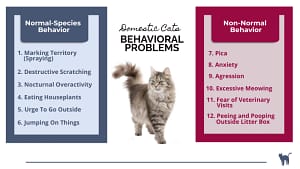




One Response
Thank you for your information on cat aggression. My 11 year old cats are siblings and have never been separated except for a vet visit which happened yesterday. Normally they have gone to get their rabies shots at the vet at the same time.
I don’t remember having this problem until yesterday.
This time, the cat that did not go to the vet (Alfy) has been hostile, hissing and growling at the other cat (Eddy) since noon yesterday when Eddy came home.
I separated them initially, and then later on, I rubbed my shirt all over on Eddy and let him sleep on it all night on my bed, to get my scent on him. Alfy was so fearful that I resorted to putting a gabapentin mixed into his food last night to try to calm him done. I awoke to hear him growling this morning. He is still growling and he would not eat his breakfast. Currently, Eddy is comfortable on my bed while Alfy is beneath, on the floor under one corner of my bed. So they are in the same room now, one on the bed, one under. I dont know what to do at this point except just wait it out and hope that Alfy recovers. It is extremely stressful for me; and I am wanting to try to find another home for Alfy if this is going to continue for the lives of the cats.